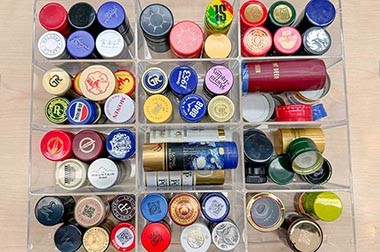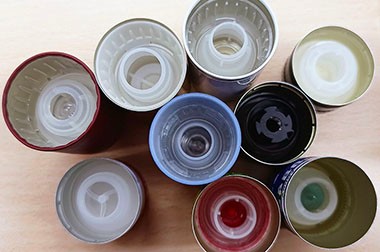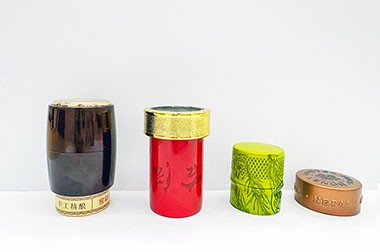Bottle Cap Decoration Processing Methods
Jun. 27, 2025
As an important component of packaging products, the decorative effect of bottle caps directly influences product visual appeal and market competitiveness. With consumers placing increasing emphasis on product appearance, cap decoration technologies are constantly innovating and evolving. At present, the most common cap materials on the market are aluminum, aluminum-plastic composite, and plastic. Due to differences in their physical and chemical properties, each material is suitable for different decoration and processing methods.
Modern cap decoration technology has evolved from single printing to an integrated application system that includes printing, hot stamping, embossing, spraying, electroplating, engraving, water transfer printing, and heat transfer printing. These techniques not only enhance the aesthetics of the cap, but also increase product added value and can even provide special functions such as anti-counterfeiting and anti-slip.
Comparison of Cap Material Properties
Various Cap Decoration Processing Technologies
Printing Technology
Printing is the most basic and commonly used technique in cap decoration and can be divided into roll-printing, side printing, and screen printing, among other types.
Roll-printing Technology
Roll-printing is an efficient continuous printing process in which a rotating printing plate transfers ink onto the surface of the cap. This technique is typically used for continuous pattern printing on flat or cylindrical surfaces and is especially suitable for circumferential decoration of round caps.
| Process Feature | Description |
| Process Principle | The printing plate of the roll-printing machine is cylindrical. When it comes into contact with the surface of the cap, ink is evenly transferred onto the cap surface through pressure and relative rotational motion. |
| Applicable Materials | Aluminum, aluminum-plastic, and plastic caps, but a high degree of surface flatness is required. |
| Cost Analysis | Equipment investment is relatively high, but production efficiency is high and unit cost is low, making it especially suitable for mass production. |
| Decorative Effect | High-precision and high-definition pattern printing with rich color layers and high overprint accuracy. |
| Efficiency Evaluation | High-speed roll-printing machines can produce up to 500 caps per minute, with high production efficiency. |
Side Printing Technology
Side printing is a printing process specifically used for decorating the sides of caps, commonly applied to the lateral surface of cylindrical or conical caps.
| Process Feature | Description |
| Process Principle | The side printing machine fixes the cap using a special fixture, aligning its axis perpendicular to the printing direction. The print head moves along the cap side to complete the pattern printing. |
| Applicable Materials | Aluminum, aluminum-plastic, and plastic caps, with strong adaptability to various materials. |
| Cost Analysis | Equipment investment is relatively small, and plate-making costs are low, but production efficiency is lower than roll printing. |
| Decorative Effect | Capable of printing complex side patterns, especially for irregularly shaped caps. It can precisely control printing position and pattern dimensions. |
| Efficiency Evaluation | Side printing speed is relatively slow, typically handling only dozens of caps per minute, suitable for small- to medium-batch production. |
Screen Printing Technology
Screen printing is a traditional but still widely used printing technique that transfers ink through a mesh screen onto the surface of the substrate using a squeegee.
| Process Feature | Description |
| Process Principle | Utilizing hollow patterns on the mesh screen, ink is transferred onto the cap surface through the screen’s openings under the pressure of a squeegee. |
| Applicable Materials | Suitable for almost all cap materials, including aluminum, aluminum-plastic, and plastic. |
| Cost Analysis | Equipment investment is low, operation is simple, and screen-making costs are minimal, making it particularly suitable for small batches and multi-variety production. |
| Decorative Effect | Thick ink layer, high color saturation, strong three-dimensional effect, especially suitable for designs requiring high coverage or special effects. |
| Efficiency Evaluation | Screen printing speed is relatively slow, usually processing only a few to a dozen caps per minute, with relatively low production efficiency. |
Hot Stamping Technology
Hot stamping, also known as heat transfer or foil stamping, is a decorative process that uses high temperature and pressure to transfer patterns from metallic foil onto the surface of a substrate.
Hot Stamping Gold Technology
Gold hot stamping is the most common form of hot stamping, mainly used to create golden patterns or text on the cap surface to enhance the product's premium appearance.
| Process Feature | Description |
| Process Principle | The stamping die heats the metallic foil, causing the release layer to melt. The adhesive layer then also melts, bonding with the substrate during pressing. The color layer and aluminum layer separate from the polyester base film and adhere to the surface of the substrate. |
| Applicable Materials | Suitable for a wide range of materials, including aluminum, aluminum-plastic, and plastic caps. |
| Cost Analysis | The equipment investment for gold stamping is moderate, but the cost of making stamping dies is relatively high, and the metallic foil is also relatively expensive. |
| Decorative Effect | The gold stamped pattern has a metallic texture, high gloss, and vibrant colors, significantly enhancing the product’s visual appeal and perceived value. |
| Efficiency Evaluation | Hot stamping speed is relatively slow, usually processing only a few to a dozen caps per minute, suitable for small- to medium-batch production. |
Silver Hot Stamping Technology
Silver hot stamping follows the same principle as gold hot stamping, differing only in the color of the foil used, and is mainly applied to create silver decorative effects on cap surfaces.
| Process Feature | Description |
| Process Principle | Identical to the gold hot stamping process, except that the metallic foil used is silver. |
| Applicable Materials | Same as gold stamping, suitable for aluminum, aluminum-plastic, and plastic caps. |
| Cost Analysis | The cost structure of silver hot stamping is similar to that of gold, with only slight differences in foil pricing. Overall cost remains comparable. |
| Decorative Effect | Silver hot stamping delivers a noble and elegant visual effect, making it ideal for product designs with minimalist and modern styles. |
| Efficiency Evaluation | Production efficiency is the same as gold hot stamping—relatively slow and suitable for small- to medium-batch production. |
Other Hot Stamping Techniques
- Top hot stamping
- Side hot stamping
- Position hot stamping
- Raised Foil Stamping
- Silk Screen Foil Stamping
Embossing Technology
Embossing is a decorative process that creates raised or recessed patterns on the surface of the cap through applied pressure. It can be categorized into standard embossing and combined gold stamping embossing processes.
Embossed Foil Stamping Technology
Embossed foil stamping is a composite decoration technique that combines foil stamping and embossing to produce three-dimensional metallic patterns on the cap surface.
| Process Feature | Description |
| Process Principle | Typically follows the sequence of gold stamping first, then embossing, though both processes can also be completed simultaneously in a single step. |
| Applicable Materials | Mainly suitable for aluminum and aluminum-plastic caps due to their good ductility. |
| Cost Analysis | Relatively high cost due to the need for specialized molds and equipment, and the complexity of the production process. |
| Decorative Effect | Can create patterns with strong three-dimensional and metallic effects, offering a powerful visual impact and unique tactile feel. |
| Efficiency Evaluation | Lower production efficiency, usually requiring multiple steps and a longer production cycle. |
Transfer Printing Technology
Transfer printing is also a commonly used technique in cap decoration and can be divided into types such as heat transfer printing and water transfer printing.
Heat Transfer Printing Technology
Heat transfer printing is a decorative process that uses heat and pressure to transfer pre-printed patterns from transfer film onto the surface of a substrate. It is widely applied in various packaging and decorative fields.
| Process Feature | Description |
| Process Principle | Utilizes thermal energy to sublimate or melt the ink on the transfer film, then transfers the pattern onto the cap surface through pressure. |
| Applicable Materials | Suitable for a variety of cap materials, including aluminum, aluminum-plastic, and plastic. |
| Cost Analysis | Equipment investment is moderate, but the cost of transfer film is relatively high, resulting in a higher unit cost. |
| Decorative Effect | The patterns are vivid and highly saturated, capable of realistically reproducing complex designs and photo-grade images. |
| Efficiency Evaluation | Heat transfer printing speed is relatively slow, with each transfer cycle taking from several tens of seconds to a few minutes. |
Water Transfer Printing Technology
Water transfer printing is a decorative process that transfers flat patterns onto three-dimensional curved surfaces, enabling continuous and complete designs on complex-shaped objects.
| Process Feature | Description |
| Process Principle | The pre-printed water transfer film is soaked in water to dissolve the water-soluble adhesive layer, separating the pattern layer from the base paper. The cap to be decorated is then immersed into the water, and water pressure is used to transfer the pattern onto the surface of the cap. |
| Applicable Materials | Applicable to various cap materials including aluminum, aluminum-plastic, and plastic. |
| Cost Analysis | Equipment investment is relatively low, but the cost of producing water transfer film is high, resulting in higher unit costs. |
| Decorative Effect | The biggest advantage is the ability to achieve complete and continuous patterns on complex curved and irregular surfaces. |
| Efficiency Evaluation | Water transfer printing is relatively slow, with each transfer cycle usually taking several to over ten minutes. |
Other Technologies
- Roller Coating
- Spraying
- Electroplating
- Engraving
- Water Plated Brushed Finish
- Crystal Head
Selection and Comparison of Decoration Techniques for Different Types of Caps
Decorative Process Analysis of Aluminum Caps
Due to the material properties and special application scenarios of aluminum caps, there are specific requirements and adaptability for decoration processes.
| Feature | Description |
| Applicable Processes | Printing, hot stamping, embossing, electroplating, engraving, and heat transfer printing |
| Process Characteristics | High material hardness and smooth surface require strong adhesion and durability of decorative processes |
| Cost Analysis | Overall cost is high, mainly due to high material cost, complex pretreatment, and stringent process requirements |
| Efficiency Evaluation | Production efficiency depends on the specific process; printing and spraying are fast and suitable for mass production |
| Decorative Effect | Excellent, capable of achieving high gloss, metallic texture, and fine patterns |
Decorative Process Analysis of Aluminum-Plastic Composite Caps
Aluminum-plastic composite caps combine the advantages of both aluminum and plastic, and the choice of decoration process is also influenced by the material properties.
| Feature | Description |
| Applicable Processes | Printing, hot stamping, spraying, water transfer printing, and heat transfer printing |
| Process Characteristics | Combines a certain degree of rigidity and flexibility, offering strong adaptability to various decoration techniques |
| Cost Analysis | Moderate cost; material cost is lower than that of pure aluminum caps, while processing cost depends on the specific technique |
| Efficiency Evaluation | High production efficiency, especially for continuous processes such as printing and spraying, enabling high-speed production |
| Decorative Effect | Diverse; can simulate the metallic texture of aluminum caps or display the vibrant colors of plastic materials |
Decorative Process Analysis of Plastic Caps
Due to their low cost, good processability, and light weight, plastic caps occupy an important position in the packaging market, with unique decoration process characteristics.
| Feature | Description |
| Applicable Processes | Almost all decorative processes, including printing, hot stamping, spraying, electroplating, engraving, water transfer printing, and heat transfer printing |
| Process Characteristics | A wide variety of plastic types with varying properties requires customization of decoration techniques according to the specific type of plastic |
| Cost Analysis | Overall low cost due to low material cost and strong adaptability to decoration processes |
| Efficiency Evaluation | High production efficiency, especially on integrated production lines combining injection molding and decoration, enabling rapid conversion from raw material to finished product |
| Decorative Effect | Rich and varied; can achieve a wide range of colors and textures. Through different process combinations, it can simulate the appearance of various materials |
Cap Decoration Process Selection Guide and Application Recommendations
Food and Beverage Packaging Caps
Process Selection: Food and beverage packaging demands high standards for safety, corrosion resistance, and hygiene. Decoration techniques should comply with food contact regulations. Recommended techniques include:
- Printing: Use food-grade inks to ensure safety
- Spraying: Use food-grade coatings to form a protective layer resistant to chemical corrosion
- Hot Stamping: Choose solvent-free hot stamping processes to reduce volatile organic compound residues
- Engraving: A physical process with no chemical residues, offering high safety
Cosmetics and Perfume Packaging Caps
Process Selection: Cosmetics and perfume packaging aims for a high-end and exquisite look, focusing on texture and detail. Recommended techniques include:
- Electroplating: Creates a mirror-like finish or special metallic effects
- Hot Stamping (Gold/Silver): Enhances the sense of luxury and product grade
- Engraving: Fine patterns and micro-text enhance product value
- Water Transfer Printing: Creates realistic metal-like or gemstone-like effects
- Heat Transfer Printing: High-resolution patterns and photo-quality images
Pharmaceutical and Healthcare Product Caps
Process Selection: Packaging for pharmaceuticals and healthcare products emphasizes safety, functionality, and clear communication. Recommended techniques include:
- Printing: Clear text and patterns for effective information transmission
- Engraving: Permanent markings that are resistant to wear and fading
- Hot Stamping: Highlights brand names and key information
- Spraying: Forms a protective layer against contamination and chemical corrosion
Further reading : Aluminium Screw CapsAluminum ROPP CapBeer Aluminum Anti-counterfeiting Bottle CapLiquor Aluminum CapWhite Aluminum Bottle CapAluminum roll-printing and milling anti-counterfeiting bottle capWine Aluminum CapROPP Aluminum Caps for WaterBeverage Bottle Aluminum CapAluminum Caps for VinegarVodka Bottle Aluminum CapsBlack Aluminum Bottle CapRum Aluminum Screw Caps 30x35mmOlive Oil Aluminum CapAluminum Cap for Whiskey Alcohol Spirit Glass Bottle31.5x24mm embossing and milling Aluminum Cap for Alcohol Whisky VodkaAluminum Bottle Cap 30x60mm for Wine and Spirits Bottles30x43mm Wine Aluminum Cap25x43mm Aluminium Pilfer Proof Bottle Cap30x44mm Aluminum Bottle Cap for Spirits28x18mm Aluminium Closure30x35mm Aluminium ROPP Cap30x60mm Hot Stamping Cover Wine Bottle Lids - Alcohol Whiskey Vodka Aluminum Bottle Cap28mm Beverage Drinks Aluminum Cap38mm Beverage Drinks Aluminum CapNon-rifillable Aluminum Plastic Cap33x47mm Non Refillable Aluminum Plastic Bottle Cap33x47mm Aluminum Plastic Bottle Cap31.5x24mm Aluminum-Plastic Caps for Olive Oil Glass BottlesBeer Aluminum Bottle CapAluminum anti-counterfeiting bottle capPull-Off Aluminum Bottle CapTamper-Evident Aluminum Bottle Cap28mm Aluminium Screw Cap38mm Aluminium Screw Cap28mm Aluminum ROPP Cap28mm Aluminum Cap28x18mm aluminum bottle cap for Vodka28x18mm Aluminium Ropp Cap38mm Aluminum ROPP Cap38mm Aluminum Cap28mm Black Aluminium ROPP Tamper Evident Screw Cap with EPE Liner28mm Silver Aluminium ROPP Cap with LinerScrew Cap 28-400 Aluminum Gold With PE Liner28mm 28-400 Aluminum Metal Cap with Pulp & Poly Liner28mm/410 Aluminium Cap with EPE Liner28x15mm Aluminium ROPP Cap26mm 42mm Ring Pull Aluminum Cap30x60mm Aluminum Vodka Tequila Caps30x60mm Aluminum ROPP Caps for Wine Glass BottlesPull Ring Easy Open Aluminum Crown Caps30×60 mm Aluminum ROPP Caps for Whiskey Glass Bottles250 ml Bottles 28×15 mm MCA Aluminum CapsBlue Aluminum CapsRing anti-counterfeiting Aluminum Plastic CapTwist off anti-counterfeit Aluminum-Plastic CapTamper Evidence Gin Twist Off Aluminum-Plastic CapScrew out anti-counterfeiting Aluminum-Plastic Cap30x44 mm Roll on Pilfer Proof Spirits Aluminum Plastic CapOlive Oil Aluminum-plastic Caps31.5x44 mm Aluminum Plastic Cap28/400 GPI Top Embossed Aluminum-plastic Screw CapGreen Dark Oil Bottle Caps28mm Aluminum-plastic Cap33x47mm Side Emboss Aluminum Lids33x47mm Hot Foil Stamping Aluminum CapsSilk Screen Printing Aluminum-plastic CapsPlastic Tooth Anti-Counterfeiting for Plastic CapsEjected from the center Plastic CapRing anti-counterfeiting Plastic Cap33X47mm Plastic Cap with Insert33X58mm Plastic Cap for Spirit BottleAluminium Pilfer Proof Caps24mm Aluminium Screw Cap28mm Black Aluminum Screw Top Cap28mm (R3) Aluminium Screw Cap18mm Aluminium Screw Cap700 ml Bottles 28×18 mm PP Aluminum Caps30 x 35 EPE tin liner ROPP Closures30x60mm Aluminum CapAluminum Screw Caps for Wine And Spirits53-400 Aluminum Screw Cap With Customizable Liner Options18-400 Black Aluminum Screw Top Caps30x60 Screw Cap Aluminum Closure18-410 Silver Aluminum Screw Top CapPre-threaded Aluminium Screw Caps20-400 Black Aluminum Screw Top Caps24-400 Aluminum Screw Cap With Customizable Liner OptionsAluminium ROPP (18x12)18mm ROPP Aluminum Caps22mm Aluminium Ropp Caps25mm Aluminium Ropp Caps31.5 mm ROPP Aluminum Cap46 mm ROPP Aluminum Cap53 mm ROPP Aluminum CapColored ROPP Aluminum CapsPrinted ROPP Aluminum Caps38-400 Aluminum Cap20-410 Silver Aluminum Bottle Cap24-410 Aluminum Cap33x58 Pilfer-Proof ROPP Aluminum Cap38x18mm Aluminum ROPP Cap30x44mm Aluminum Screw CapRed 28mm ROPP Aluminum Closure45-400 Aluminum Screw Caps22-400 Aluminum Cap22-410 Aluminum Cap33-410 Aluminum Cap24 415 Aluminium Screw CapBrushed aluminium screw caps





